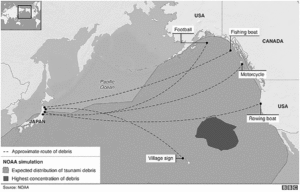Dramaturgy by Helen Raines, Book-It Artistic Intern

As of 2015, approximately 1 million tons of debris was still lingering in the Pacific Ocean after the March 2011 magnitude 9.0 earthquake—the most powerful ever recorded in Japan—set off a series of massive tsunami waves that killed 15,000 and devastated much of the country’s Pacific coastline.
Millions of tons of wreckage were swept into the Pacific Ocean, most of which sank. However, items with buoyancy were swept up by the ocean’s currents and onto western shores of North America via the system of currents in the Pacific Ocean called the North Pacific Gyre. Because of the Earth’s rotation, winds, and storms, the floating debris makes its way to coastlines from southern Alaska to Mexico.
Even five years after the tsunami, debris continues to arrive by wave: refrigerators, motorcycles, sports balls, and fishing boats have made the journey and are being collected, catalogued, and returned if the owners can be found.
“Each gyre orbits at its own speed. And the length of an orbit is called a tone. Isn’t that beautiful? Like the music of the spheres. All that stuff from people’s homes in Japan that the 2011 tsunami swept out to sea? They’ve been tracking it and predicting it will wash up on our coastline.”
—Oliver, A Tale for the Time Being